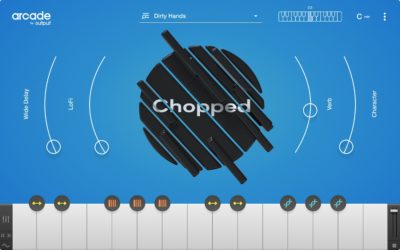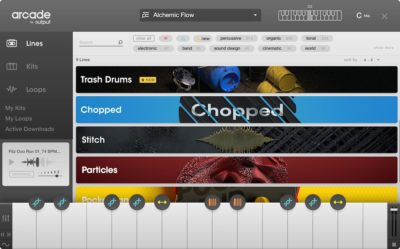New Software Review: Arcade by Output

Output’s Arcade is a unique subscription-based loop synthesizer plugin with an extensive built-in library of expertly-curated content. Can this inspiring tool help you in your next project?
Arcade is a loop synthesizer plugin that allows you to make use of an extensive library of carefully curated content from Output that is stored in the cloud.
The Arcade in-app browser contains an extensive streamable and downloadable library of loops. And, because all the loops are auditioned and downloaded directly within Arcade, it means there’s no fussing around with an internet browser.
This unique plugin allows you to apply extreme audio manipulation to the loops you download, and it also provides a number of tools that will allow you to mix these loops. Today we’ll take an in-depth look at what Arcade has to offer.
Features
Arcade’s browser allows you to search, preview, and load kits found within the plugin itself, enabling you to audition content and download only what you need. The browser is broken down into 3 categories: Product Lines (Lines), Kits, and Loops.
Lines are collections of sounds that each offer a particular vibe. Each line is broken down into different kits. A kit contains 15 curated loops, implementing modifiers, macros, effects, and modulation; these are essentially like presets. As new kits are introduced, a little yellow icon that says “New” will appear next to each item, making it easy to identify. Additionally, Arcade allows you to use your own loops, as well as create your own kits from scratch.
Arcade’s synth allows you to play and transform the loops you download, and the synth engine turns the loop you download into playable instruments. You can modify the sound of these instruments using the black keys on your MIDI keyboard, or with macro sliders, modulation, and effects.
There are custom macro sliders explicitly designed for each kit. You can modify the macros included in each kit by opening the Macro Overview and making changes as you see fit. Making your own kit from scratch will clear all these macro settings so that you’re working with a clean slate.
Arcade uses two octaves of your keyboard; loops are loaded onto the white keys, while the black keys modify them in real time. The currently available modifiers include Resequence, Playhead, and Repeater. Resequence creates entirely new musical sequences out of the original loop; this feature will ensure you don’t end up with the exact same loop sequences as other people using Arcade. Playhead jumps to different points in the audio and allows you to play back audio in reverse. Repeater repeats different sections of your loop at various speeds and sizes.
Each white key has an Edit function that allows you to apply significant audio manipulation to each loop. The edit controls will enable you to manipulate volume, panning, attack time, release time, crossfade time, speed, tuning, send level, grid size, and filters. It also allows you to reverse audio and manipulate the playback region of samples. In the Advanced section of this editor, you can adjust the loop’s original tempo and key; it’s vital that you set this information correctly when using your own loops.
Arcade’s Mixer section provides you with a channel strip for each loop, allowing you to control the volume, pan, and send level for each white key. There’s also a master bus that will enable you to manage its level and pan, as well as insert 4 different audio effects of your choice. The available effects include a chorus, compressor, multi-tap delay, stereo delay, distortion box, equalizer, filter, limiter, lo-fi effect, phaser, and reverb. Each send allows you to load up 2 of these effects. You can also apply 4 of these effects to the master channel.
Assigning modulation to the controls in the Mixer section is easy; just right-click on a parameter and select the modulation source you’d like to apply. This allows you to add some animated movement to each channel strip.
In the bottom right corner of Arcade, there’s another master volume output. I’m not sure why there are two master volume outputs, but the one in the bottom right corner is accessible regardless of which window you have pulled up in Arcade. Below this control, there’s a square icon that lets you stop playback of all loops.
All the loops you download from the Arcade browser lock to the host tempo of your DAW. You can also select the key of the loops you download to match the key of the session you’re working on.
The Arcade dashboard allows you to control global settings like speed, legato, and input quantize. It will also let you change the location of where you save your samples. I store my samples on an external hard drive, so that’s where I relocated the Arcade sample folder.
In addition, a small feature that I think is worth mentioning is the ability to resize the Arcade window by dragging on its corner. This would allow you to quickly move the plugin over to a secondary monitor and resize it to fit the screen.
In Use
The first thing you’ll notice when you open Arcade is its beautiful, modern looking interface. Output does a great job with all their GUIs, and they didn’t disappoint with Arcade. Not only is it aesthetically pleasing, but the layout of all the windows, tabs, and parameters is intuitive, and above all, makes sense. There are many controls that Arcade offers, and in terms of organization, Output really knocked it out of the ballpark.
I thought I would be comparing Arcade to Splice in the sense that they both allow you to download loops. Splice offers a tremendous number of loops, so my initial thought was “How can Arcade even try to compete?” However, upon diving into Arcade, I realized that comparing it to Splice wouldn’t be fair at all. Arcade offers you an entire synth engine with loops that are already prepared for it.
While Splice focuses on quantity, Arcade focuses on quality. Pretty much anyone can upload samples to Splice, but all of Arcade’s samples are created in-house at Output. Using Arcade is refreshing because you don’t need to sort through countless samples to find one that is useable. Splice and Arcade play nice with one another, and you can create your own kits by dragging your Splice loops right into Arcade.
One of the nice things about the subscription service is that you aren’t bound to it once you’ve created a song with Arcade. Your sessions using Arcade will still play back even if you cancel your subscription. I think Output made the correct ethical choice by not enslaving people to their product. This also makes jumping into Arcade risk-free, which will be a big help in terms of extending the overall reach of the plugin.
Because Arcade is subscription based, I believe it’s acceptable to hold Output to a high standard when it comes to generating more loop content. Currently, there are 23 Lines that contain Kits and Loops. New Loops and Kits are released every day, and a new Line is released approximately every 3-4 weeks. Existing Lines are constantly upgraded with new content, reinforcing the fact that Output is very serious about dishing out value to their Arcade subscribers.
To Be Critical
Downloading only the content you need is a great idea, but if your internet connection is no good, this can really kill your creative workflow. Additionally, if you’re working somewhere without an internet connection, you’re out of luck as you won’t be able to download new loops. The solution to this is to just download everything from the Arcade browser in advance if you know you’ll be without internet. The content is stored in a folder on your computer or external hard drive—you just need to make sure that you have room for it.
I also would have liked to have been able to route each channel mixer to its own track in my DAW. Mixing in the Arcade plugin is possible, but it doesn’t fit my workflow. This was very likely the biggest issue I had with Arcade.
Summing it Up
Overall, I’m quite impressed with Arcade. It’s a fun tool based on a unique concept with a beautiful interface. It takes the attractive online features of apps like Splice and integrates it into a powerful synthesizer.
Arcade is unlocked by purchasing Output’s subscription plan. It’s very similar to the way Splice works, in the sense that you pay a monthly fee, and then gain access to samples. However, Arcade does not work using a credit system. You gain full access to everything Arcade has to offer with your monthly subscription, which is priced at $10/month.
Arcade is also soon to receive a V1.2 update that promises some reworks and new features. There’s going to be a new browser homepage feed, new search abilities like partial text search, tag search, and searching within a single lines view. Other updates include automatic key and tempo detection, the ability to cycle through kits faster with convenient Previous/Next buttons, and new subpresets for modifiers, effects modules, and modulation sources. You’ll also be able to copy, paste, and save presets for modifiers, effects modules, and modulation sources. Perhaps the most exciting new update is that Arcade will be available as a standalone software, allowing you to play Arcade without the use of a DAW.
Output has developed something truly unique with the creation of Arcade. With unlimited access to the Arcade browser at such an affordable price point, Hip-Hop producers are going to absolutely love this product, as will anyone else who relies heavily on loop-based content. Output went out on a limb with this plugin, and I think their gamble is surely going to pay off.
Charles Hoffman is a Mixing and Mastering Engineer at Black Ghost Audio. After graduating from the University of Manitoba with an English degree, Charles completed his education at Icon Collective in Los Angeles, CA.
Please note: When you buy products through links on this page, we may earn an affiliate commission.







